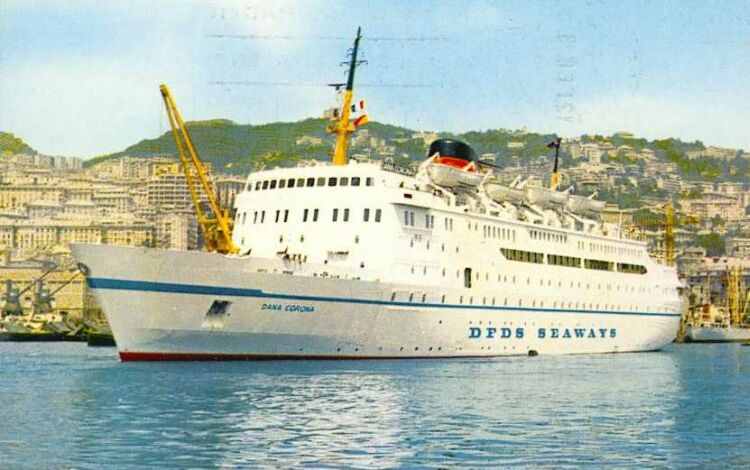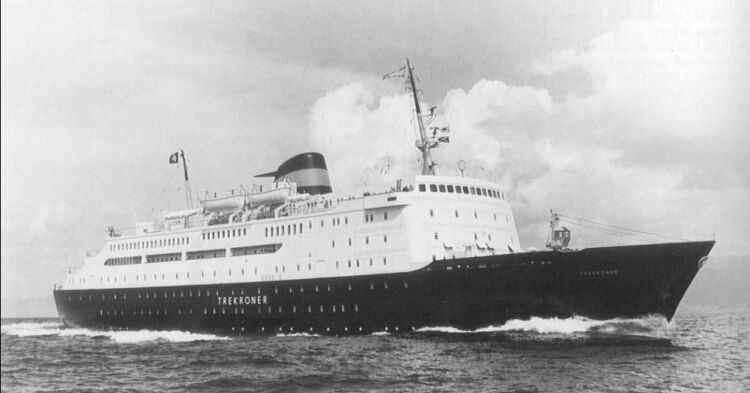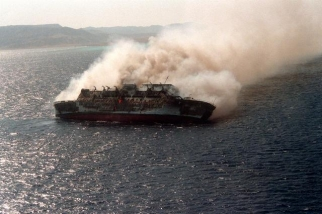The story of the Al-Qamar Al-Saudi Al-Misr is a tale of transformation, service, tragedy, and discovery. Originally built as the Danish ferry Trekroner, this vessel’s journey across seas and borders culminated in one of the Red Sea’s most haunting shipwrecks, now a challenging dive site for technical divers.
From Danish Waters to the Red Sea
The ship that would eventually become the Al-Qamar Al-Saudi Al-Misr began its life as the 7,697 GRT Roll On/Roll Off passenger ferry Trekroner. Constructed at Cantieri Navali del Tirreno e Riuniti in Riva Trigoso, Genoa, Italy, the ship was commissioned by Det Forenede Dampskibs-Selskab (The United Steamship Company) in Copenhagen, Denmark. The keel was laid in April 1967, and the ship was launched on March 27, 1970. By March 30, 1970, the vessel was completed and ready to sail.
With a crew of 67, the Trekroner was designed to carry up to 718 passengers and 120 automobiles. However, modifications in October 1970 at Anciens Etablissement Groignard in Marseille, France, reduced the ship’s passenger capacity to 622, as additional staterooms were added.
Initially operating routes between Genoa, Palma, Malaga, and Ibiza/Tunis, the vessel was renamed Dana Corona in June 1971. Later, it became Dana Sirena in November 1979, serving routes between Ancona, Patras, Iraklion, and Alexandria before being decommissioned in Copenhagen on December 6, 1982.
The Ship’s Transformation and New Identity
On February 7, 1983, the ship found a new owner in Al Sabah Maritime Services Co., Jeddah, Saudi Arabia. It was renamed Al-Qamar Al-Saudi II and began operating in the Red Sea between Suez, Aqaba, and Jeddah. The ship’s journey was not without incident; in 1983, it collided with the passenger ship M/V Durr in the Red Sea.
In August 1988, the ship changed hands again, sold to the Khalid Ali Fouda Shipping Co. (possibly known as “Marine Glory Shipping”) in Alexandria, Egypt. It was re-flagged under Panamanian registry and renamed Al-Qamar Al-Saudi. By 1989, the vessel had adopted its final name: Al-Qamar Al-Saudi Al-Misr.
The Final Voyage and Tragic Loss
On June 18, 1994, the Al-Qamar Al-Saudi Al-Misr was returning from Jeddah to Suez with 527 passengers and 63 crew members on board. Late that evening, a catastrophic boiler explosion triggered a major fuel oil leak in the engine room, igniting a fire that rapidly spread throughout the vessel.
A mayday signal was sent, and several vessels responded to the distress call. Lifeboats were lowered, and passengers began jumping overboard to escape the spreading flames. The USS Briscoe, a U.S. Navy destroyer, was the closest vessel to the scene, approximately 25 miles away. The Briscoe acted as the On-Scene Command Center during the rescue operations, coordinating efforts to save passengers and crew.
Despite the rescue efforts, the fire raged throughout the night, and the ship ultimately sank the following morning at coordinates 27.31.180N / 33.51.670E in 83 meters of water. The disaster claimed the lives of eight people, with 13 others reported missing and presumed dead. Additionally, 50 passengers sustained injuries.
Other rescue efforts included the USS Stephen W. Groves (FFG-29) and the USNS Henry J. Kaiser, which served as the collection ship for the injured and deceased. Eric Binge, a sailor and registered EMT aboard the Groves, assisted in the rescue operations after being flown to the Kaiser by an SH-60 helicopter.
The Wreck’s Discovery and Diving Opportunities
The wreck of the Al-Qamar Al-Saudi Al-Misr was discovered in August 2006 by Paul Vinton, a Tekstreme Supervisor at Emperor Divers in Hurghada, Egypt. Vinton and his team of technical divers located the ship at a depth of 83 meters, making it a challenging site suitable for experienced technical divers.
Measuring 124.85 meters in length with a beam of 19.31 meters, the ship was powered by twin 12-cylinder B&W 1242-VT2BF-90 diesel engines, enabling it to reach a maximum speed of 21 knots. The wreck lies in a remote area of the Red Sea, presenting a fascinating yet somber dive experience.
For divers interested in exploring the wreck, it’s essential to have advanced technical diving certifications and experience in deep wreck diving. The site offers a glimpse into maritime history and the tragic end of a ship that had seen decades of service across Europe and the Middle East.
A Legacy of Service and Tragedy
The Al-Qamar Al-Saudi Al-Misr’s journey from Danish ferry to Red Sea tragedy is a poignant reminder of the unpredictability of maritime life. Its wreck now stands as a solemn underwater memorial, offering divers a chance to reflect on the ship’s storied past and the lives it touched along the way.
Information provided by The Red Sea Wreck Project









